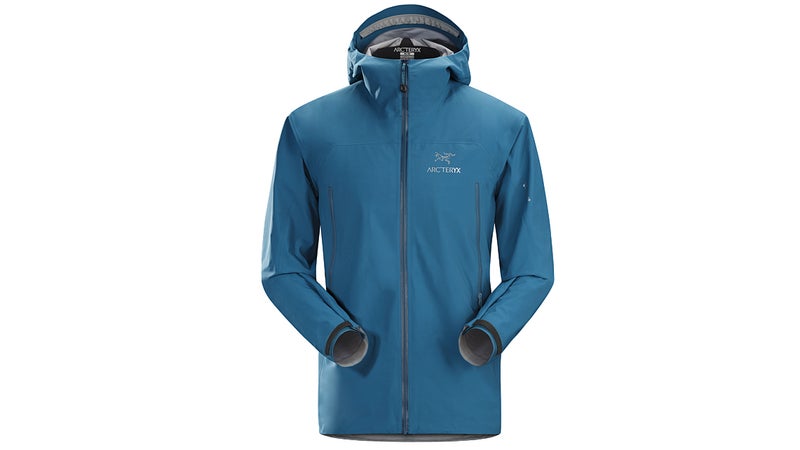When it comes to jackets, the cost is all in the fabric. Most high-end Gore-Tex shells come in around an eye-watering $500—the kind of outerwear designed to stand up to the toughest, wettest, coldest conditions. It’s also perfectly feasible to find a jacket in the $100 range made from a cheaper, off-brand material. But just how big is the performance difference between these two options? I wanted to find out.
The Test
For the comparison, I tested Columbia’s PFG Storm jacket, which uses the brand’s in-house waterproof-breathable membrane, against the Arc’teryx Zeta AR jacket, which uses Gore-Tex with a soft, light C-knit backer. Key aspects that I looked at were breathability, waterproofing, and packability.
Breathability: I wore each jacket over a synthetic T-shirt on my go-to three-mile lunch run, which has about 700 feet of elevation gain in the first mile. At certain predetermined spots, I stopped to take note of how much moisture had accumulated inside.
Wateproofing: I put on a cotton T-shirt, threw on the jacket, tightened the hood, and stood in my shower for five minutes, facing the spigot with my head down to mimic how I would walk through a storm. Then I turned around and spent five minutes with the shower spraying my back. Afterward, I checked to see if the T-shirt was wet.
Packability: I weighed each jacket on a kitchen scale, then bunched it down as small as I could. Finally, I threw each jacket into a full pack to see how much room it took up.
Columbia Men’s PFG Storm Jacket ($70)

Breathability: It was 58 degrees when I started my run, and my first sweat check came after the big initial climb (8 minutes 31 seconds into the route). A large V-shaped patch of sweat ended below my chest, and a solid three-inch-wide line of sweat ran down my back. At 10 minutes 39 seconds, sweat started to drip out of the arms, and my shirt was totally soaked. I was extremely uncomfortable and took the jacket off.
Waterproofing: I stayed completely dry in the shower. Note: the hood’s brim held up well to a full-blast showerhead and didn’t cave or let water seep in at the sides.
Packability: The 13.9-ounce jacket bundled up to the size of a small cantaloupe. This wouldn’t bother me if I was out on a day hike and had room in my pack. Nor would I mind stuffing this into the body of my 55-liter backpacking pack. But it barely fit in the front pouch of my big pack and took up too much room in the lid, which are the accessible places I’d want to store a rain jacket. If I were pinched for space by a smaller mountaineering pack, this jacket wouldn’t work.
Arc’teryx Zeta AR Jacket ($425)

Breathability: It was 62 degrees when I started running, and a friend joked that I wouldn’t make it more than ten minutes before wanting to pull the jacket off. He was wrong. The jacket never got so hot or sweaty that I felt like ripping it off, and I ended up wearing it for my entire 45-minute, 3.11-mile run. My armpits were plenty soaked at the end, but my back and chest had only small pockets of sweat.
Waterproofing: I stayed completely dry in both directions.
Packability: This 11.7-ounce jacket packed down to the size of a large apple—overall, about a third smaller than the Columbia. It was easier to shove into the brain of my backpacking pack, but I wouldn’t take it on a light-and-fast alpine climb.
Takeaways
The Arc’teryx was significantly more breathable, weighed less, and packed down better, but are those features worth an extra $355? It depends on what you’re planning to use it for.
If you’re getting after it outside and don’t want to sweat, I’d suggest you spend the money on a jacket with a Gore-Tex or other high-end membrane. A sweaty jacket is uncomfortable, yes, but sweat is also your enemy in the high alpine. If your mid- or base layer is soaked when the temperature drops, that’s an easy way to get hypothermia. Don’t discount the weight and space savings, either. A smaller jacket means more room in your bag for food or other necessary items.
If, however, you just want a dependable rain jacket for cruising around the city, car camping, or even a mellow hike—and one that will keep you totally dry in these conditions, assuming the weather is cool enough that you’re not sweating—save your money and go with something like the Columbia. It’s totally waterproof and breathes okay.

